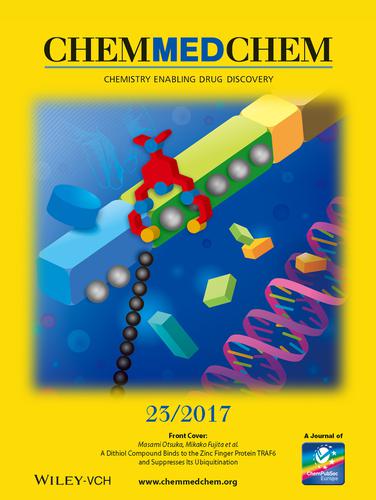当前位置:
X-MOL 学术
›
ChemMedChem
›
论文详情
Our official English website, www.x-mol.net, welcomes your
feedback! (Note: you will need to create a separate account there.)
Front Cover: A Dithiol Compound Binds to the Zinc Finger Protein TRAF6 and Suppresses Its Ubiquitination (ChemMedChem 23/2017)
ChemMedChem ( IF 3.6 ) Pub Date : 2017-12-07 , DOI: 10.1002/cmdc.201700735 Ryoko Koga 1 , Mohamed O. Radwan 1, 2 , Tomohiko Ejima 1 , Yosuke Kanemaru 1 , Hiroshi Tateishi 1 , Taha F. S. Ali 1 , Halil Ibrahim Ciftci 1 , Yuri Shibata 3 , Yuu Taguchi 3 , Jun-ichiro Inoue 3 , Masami Otsuka 1 , Mikako Fujita 4
ChemMedChem ( IF 3.6 ) Pub Date : 2017-12-07 , DOI: 10.1002/cmdc.201700735 Ryoko Koga 1 , Mohamed O. Radwan 1, 2 , Tomohiko Ejima 1 , Yosuke Kanemaru 1 , Hiroshi Tateishi 1 , Taha F. S. Ali 1 , Halil Ibrahim Ciftci 1 , Yuri Shibata 3 , Yuu Taguchi 3 , Jun-ichiro Inoue 3 , Masami Otsuka 1 , Mikako Fujita 4
Affiliation

|
The Front Cover shows that a dithiol compound named SN‐1 binds to TRAF6 protein and suppresses its auto‐ubiquitination and downstream NF‐κB activation to express proteins related to cancer and inflammation. The TRAF6 has five zinc fingers C‐terminal to the N‐terminal RING finger domain with two zincs. SN‐1 is considered to bind directly to a zinc of the first zinc finger, disrupting ubiquitin ligase activity of the neighboring RING finger. This study shows a platform for new small molecules targeting zinc finger proteins, coming after the conventional drugs targeting zinc enzymes. Cover illustration by Hiroe Kamasaki, Soft Sync Inc. More information can be found in the Full Paper by Masami Otsuka, Mikako Fujita et al. on page 1935 in Issue 23, 2017 (DOI: 10.1002/cmdc.201700399).

中文翻译:

前盖:一种二硫醇化合物与锌指蛋白TRAF6结合并抑制其泛素化(ChemMedChem 23/2017)
封面显示,一种名为SN-1的二硫醇化合物与TRAF6蛋白结合并抑制其自体泛素化和下游NF-κB活化,以表达与癌症和炎症相关的蛋白。TRAF6在N端RING指域的C端有五个锌指,带有两个锌。SN-1被认为直接与第一个锌指的锌结合,从而破坏了相邻RING指的泛素连接酶活性。这项研究显示了针对锌指蛋白的新小分子的平台,这是继针对锌酶的常规药物之后的平台。封面插图由Soft Sync Inc.的Kaoaki Hiroe所著。有关更多信息,请参见Masami Otsuka的完整论文,Mikako Fujita等人的文章。在2017年第23期的第1935页 (DOI:10.1002 / cmdc.201700399)。

更新日期:2017-12-07

中文翻译:

前盖:一种二硫醇化合物与锌指蛋白TRAF6结合并抑制其泛素化(ChemMedChem 23/2017)
封面显示,一种名为SN-1的二硫醇化合物与TRAF6蛋白结合并抑制其自体泛素化和下游NF-κB活化,以表达与癌症和炎症相关的蛋白。TRAF6在N端RING指域的C端有五个锌指,带有两个锌。SN-1被认为直接与第一个锌指的锌结合,从而破坏了相邻RING指的泛素连接酶活性。这项研究显示了针对锌指蛋白的新小分子的平台,这是继针对锌酶的常规药物之后的平台。封面插图由Soft Sync Inc.的Kaoaki Hiroe所著。有关更多信息,请参见Masami Otsuka的完整论文,Mikako Fujita等人的文章。在2017年第23期的第1935页 (DOI:10.1002 / cmdc.201700399)。












































 京公网安备 11010802027423号
京公网安备 11010802027423号